MODIS土地覆盖分类方法精品PPT课件
- 格式:ppt
- 大小:10.04 MB
- 文档页数:69

MODIS土地覆盖分类1. 简介MODIS(Moderate Resolution Imaging Spectroradiometer)是美国国家航空航天局(NASA)和美国地球观测卫星数据与信息中心(LP DAAC)联合研发的一种被动遥感传感器。
MODIS传感器可以获取全球范围内的高分辨率、高频次的多光谱遥感影像数据。
其中,MODIS土地覆盖分类是利用MODIS传感器获取的遥感影像数据进行土地类型分类和监测。
2. MODIS土地覆盖分类原理MODIS土地覆盖分类主要基于遥感影像数据的光谱信息和纹理特征进行分析和判别。
具体步骤如下:2.1 数据预处理首先,对获取的MODIS遥感影像数据进行预处理。
预处理包括辐射校正、大气校正、几何校正等,以消除不同时间、不同空间条件下影像的差异性。
2.2 特征提取接下来,从预处理后的遥感影像中提取特征。
常用的特征包括光谱特征和纹理特征。
•光谱特征:通过计算遥感影像中各个波段的反射率或辐射亮度,得到每个像元的光谱特征。
这些特征可以反映不同土地类型在不同波段上的表现差异。
•纹理特征:通过计算遥感影像中像元间的灰度差异、空间关系等信息,得到每个像元的纹理特征。
这些特征可以反映土地覆盖类型的空间分布和结构。
2.3 分类算法基于提取到的特征,使用分类算法对遥感影像进行分类。
常用的分类算法包括支持向量机(SVM)、随机森林(Random Forest)等。
这些算法可以根据已知土地类型的样本数据进行训练,并将训练得到的模型应用于未知土地类型的遥感影像数据。
2.4 精度评价最后,对分类结果进行精度评价。
通常采用混淆矩阵、Kappa系数等指标来评估分类结果与实际情况之间的一致性和准确性。
3. MODIS土地覆盖分类应用MODIS土地覆盖分类在环境监测、资源管理、城市规划等领域具有广泛应用。
3.1 环境监测MODIS土地覆盖分类可以用于监测和评估生态环境的变化。
通过对不同时间段的遥感影像数据进行分类,可以获得土地覆盖类型的时空变化信息。

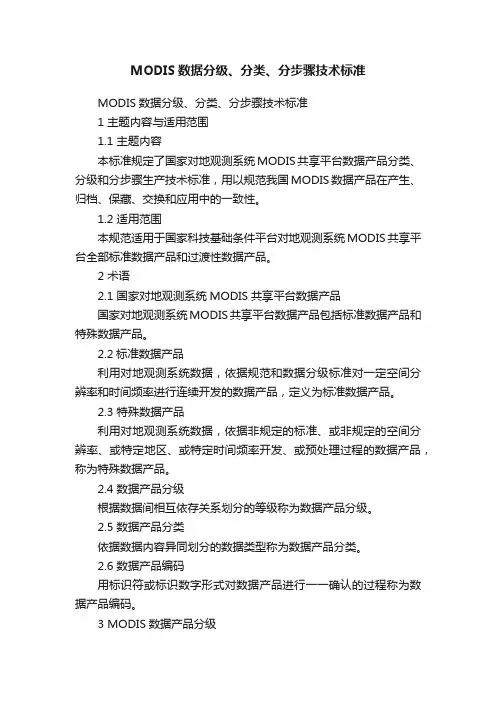
MODIS数据分级、分类、分步骤技术标准MODIS数据分级、分类、分步骤技术标准1 主题内容与适用范围1.1 主题内容本标准规定了国家对地观测系统MODIS共享平台数据产品分类、分级和分步骤生产技术标准,用以规范我国MODIS数据产品在产生、归档、保藏、交换和应用中的一致性。
1.2 适用范围本规范适用于国家科技基础条件平台对地观测系统MODIS共享平台全部标准数据产品和过渡性数据产品。
2 术语2.1 国家对地观测系统MODIS共享平台数据产品国家对地观测系统MODIS共享平台数据产品包括标准数据产品和特殊数据产品。
2.2标准数据产品利用对地观测系统数据,依据规范和数据分级标准对一定空间分辨率和时间频率进行连续开发的数据产品,定义为标准数据产品。
2.3 特殊数据产品利用对地观测系统数据,依据非规定的标准、或非规定的空间分辨率、或特定地区、或特定时间频率开发、或预处理过程的数据产品,称为特殊数据产品。
2.4 数据产品分级根据数据间相互依存关系划分的等级称为数据产品分级。
2.5 数据产品分类依据数据内容异同划分的数据类型称为数据产品分类。
2.6 数据产品编码用标识符或标识数字形式对数据产品进行一一确认的过程称为数据产品编码。
3 MODIS数据产品分级3.1 MODIS数据产品分级系统MODIS标准数据产品分级系统由5级数据构成,它们分别是:0级、1级、2级、3级和4级。
3.2 0级数据卫星地面站直接接收到的、未经处理的、包括全部数据信息在内的原始数据为0级数据。
3.3 1级数据对没有经过处理的、完全分辨率的仪器数据进行重建,数据时间配准,使用辅助数据注解,计算和增补到0级数据之后为1级数据。
3.4 2级数据在1级数据基础上开发出的、具有相同空间分辨率和覆盖相同地理区域的数据为2级数据。
3.5 3级数据3级数据是以统一的时间-空间栅格表达的变量,通常具有一定的完整性和一致性。
在3级水平上,将可以集中进行科学研究,如:定点时间序列,来自单一技术的观测方程和通用模型等。


第3期,总第85期国 土 资 源 遥 感No.3,2010 2010年9月15日REMOTESENSINGFORLAND&RESOURCESSep.,2010 基于波段选择的MODIS全国土地覆盖分类赵德刚1,2,占玉林3,刘翔4,刘成林2,庄大方5(1.连云港市规划市政设计研究院,连云港 222001;2.南昌大学建筑工程学院,南昌 330031;3.中国科学院遥感应用研究所遥感科学国家重点实验室,北京 100101;4.北京东方泰坦科技股份有限公司,北京 100083;5.中国科学院资源环境科学数据中心,北京 100101)摘要:以MODIS多光谱和多时相数据为输入参数进行了全国土地覆盖分类研究。
从试验区2007年MODIS8d数据的合成影像(MOD09)中提取EVI、NDWI和NDSI3个指数,并将其作为特征波段与原有的7波段(B1~B7)形成10波段影像。
以统计分类J-M距离平均值和SVM分类总精度为标准评价不同波段对土地覆盖分类的贡献。
在全国范围内,选择贡献最大的EVI、B7和B4这3个波段的月合成值,并分别对其作PCA变换,选取各PCA变换后的前3个波段进行分类运算。
研究结果表明,在没有其他辅助信息的境况下,基于MODIS贡献最大的前3个波段结合多时相信息能够在中分辨率区域土地覆盖分类中取得较好的分类结果,其精度为78.04%。
关键词:MODIS;J-M距离;土地覆盖分类;SVM中图分类号:TP79 文献标识码:A 文章编号:1001-070X(2010)03-0108-06收稿日期:2009-11-19;修订日期:2009-12-28基金项目:国家高技术研究发展计划(编号:2006AA12Z142、2006AA12010106)、对地观测技术国家测绘局重点实验室经费资助项目(编号:200806)、中国科学院知识创新工程青年人才领域前沿项目专项项目、中国科学院遥感应用研究所遥感科学国家重点实验室和投资项目遥感动态监测与管理信息系统(国家863计划,编号:2006AA120107)资助项目共同资助。
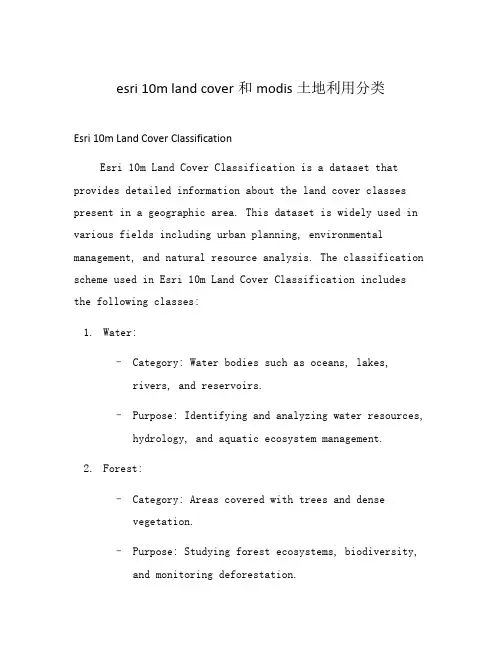
esri 10m land cover和modis土地利用分类Esri 10m Land Cover ClassificationEsri 10m Land Cover Classification is a dataset that provides detailed information about the land cover classes present in a geographic area. This dataset is widely used in various fields including urban planning, environmental management, and natural resource analysis. The classification scheme used in Esri 10m Land Cover Classification includes the following classes:1.Water:–Category: Water bodies such as oceans, lakes,rivers, and reservoirs.–Purpose: Identifying and analyzing water resources, hydrology, and aquatic ecosystem management.2.Forest:–Category: Areas covered with trees and densevegetation.–Purpose: Studying forest ecosystems, biodiversity, and monitoring deforestation.3.Agricultural land:–Category: Land used for cultivating crops, raising livestock, and other agricultural purposes.–Purpose: Analyzing agricultural practices, crop yield estimation, and land management strategies. 4.Grassland:–Category: Areas dominated by grass or herbaceous vegetation.–Purpose: Monitoring changes in grassland ecosystems, grazing patterns, and wildlife habitat analysis.5.Urban areas:–Category: Areas characterized by human-madestructures and infrastructure.–Purpose: Urban planning, land use change analysis, and understanding the impacts of urbanization.6.Wetland:–Category: Land that is permanently or temporarily covered with water.–Purpose: Wetland conservation, studying waterresource management, and habitat assessment.7.Barren land:–Category: Areas devoid of vegetation or with sparse vegetation cover.–Purpose: Studying desertification, land degradation, and identifying areas suitable for afforestation. 8.Snow and ice:–Category: Areas covered with snow, glaciers, or ice.–Purpose: Monitoring changes in snow cover, glacial retreat, and analyzing the impacts of climatechange.MODIS Land Use ClassificationMODIS (Moderate Resolution Imaging Spectroradiometer) Land Use Classification is another widely used dataset that provides information about the various land use classes in a specific region. This dataset has a coarser resolution compared to Esri 10m Land Cover Classification but covers a larger area. The land use classes in MODIS Land Use Classification include the following:1.Cropland:–Category: Land used for agricultural purposes, including cultivation of crops.–Purpose: Monitoring agricultural practices,analyzing crop patterns, and estimating cropproductivity.2.Grassland:–Category: Land predominantly covered with grasses or herbaceous vegetation.–Purpose: Evaluating grazing practices, studying grassland dynamics, and wildlife habitat analysis.3.Urban and built-up:–Category: Areas characterized by human-madestructures, urban development, and infrastructure.–Purpose: Urban planning, understanding urban expansion patterns, and analyzing the impacts ofurbanization.4.Forest and woodland:–Category: Areas covered with trees and forests.–Purpose: Studying forest ecosystems, monitoring deforestation, and assessing biodiversity.5.Water bodies:–Category: Lakes, rivers, oceans, and other water bodies.–Purpose: Analyzing water resources, hydrological processes, and aquatic ecosystem management.6.Shrubland:–Category: Land covered with shrubs or low-lying vegetation.–Purpose: Studying shrubland ecology, wildlifehabitat analysis, and land management strategies. 7.Desert:–Category: Barren land or areas with sparsevegetation cover.–Purpose: Understanding desertification, landdegradation, and identifying suitable areas forvegetation restoration.8.Snow and ice:–Category: Areas covered with snow, glaciers, or ice.–Purpose: Monitoring changes in snow cover,analyzing glacial retreat, and studying the impactsof climate change.These are just a few examples of the land cover and land use classifications provided by Esri 10m Land Cover and MODIS datasets. Both datasets offer valuable insights into the composition and distribution of land cover classes, allowing researchers, policymakers, and planners to make informed decisions for sustainable land management.Sure, here are more classifications from Esri 10m Land Cover and MODIS Land Use datasets:Esri 10m Land Cover Classification9.Shrubland:–Category: Land covered with shrubs or low-lying vegetation.–Purpose: Studying shrubland ecology, wildlifehabitat analysis, and land management strategies.10.Mangroves:–Category: Coastal wetlands dominated by salt-tolerant trees or shrubs.–Purpose: Monitoring and conservation of mangrove ecosystems, coastal management.11.Swamp/Marshes:–Category: Wetlands characterized by saturated soil and emergent vegetation.–Purpose: Studying wetland biodiversity, water quality, and carbon storage.12.Bare Ground:–Category: Areas devoid of vegetation or withminimal vegetation cover.–Purpose: Monitoring land degradation, erosion, and assessing soil health.13.Rock and Scree:–Category: Areas predominantly covered by rocks, stones, or loose debris.–Purpose: Studying geomorphology, landscapeevolution, and land stability analysis.MODIS Land Use Classification9.Wetland:–Category: Areas of marsh, peatland, or other wetland environments.–Purpose: Wetland conservation, water resource management, and habitat assessment.10.Plantations:–Category: Extensively managed areas with single-species plantations, such as tree plantations.–Purpose: Monitoring and managing plantation resources, evaluating land use change.11.Open Space:–Category: Land used for recreational purposes, public parks, or open areas.–Purpose: Urban planning, urban green spaces analysis, and promoting outdoor activities.12.Mining:–Category: Areas used for extraction of minerals, including open-pit mines and quarries.–Purpose: Monitoring mining activities, assessing environmental impacts, and land reclamation. 13.Built-up/Paved:–Category: Areas covered with impervious surfaces, such as buildings, roads, and parking lots.–Purpose: Urban planning, analyzing urban heatisland effect, and assessing land use changes.These additional classifications provide a more comprehensive understanding of the land cover and land use patterns in a given area. Detailed analysis of these datasets enables researchers and decision-makers to address various environmental, social, and economic challenges.。
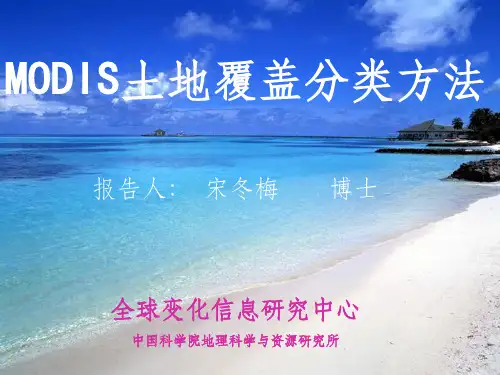

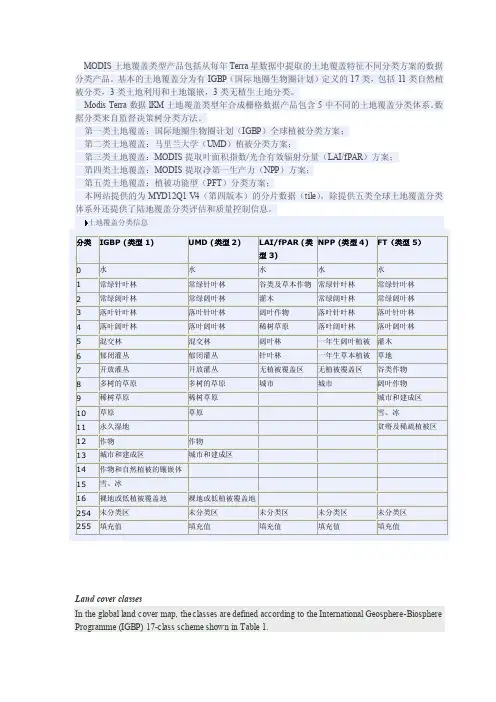
MODIS土地覆盖类型产品包括从每年Terra星数据中提取的土地覆盖特征不同分类方案的数据分类产品。
基本的土地覆盖分为有IGBP(国际地圈生物圈计划)定义的17类,包括11类自然植被分类,3类土地利用和土地镶嵌,3类无植生土地分类。
Modis Terra数据lKM土地覆盖类型年合成栅格数据产品包含5中不同的土地覆盖分类体系。
数据分类来自监督决策树分类方法。
第一类土地覆盖:国际地圈生物圈计划(IGBP)全球植被分类方案;第二类土地覆盖:马里兰大学(UMD)植被分类方案;第三类土地覆盖:MODIS提取叶面积指数/光合有效辐射分量(LAI/fPAR)方案;第四类土地覆盖:MODIS提取净第一生产力(NPP)方案;第五类土地覆盖:植被功能型(PFT)分类方案;本网站提供的为MYD12Q1 V4(第四版本)的分片数据(tile),除提供五类全球土地覆盖分类体系外还提供了陆地覆盖分类评估和质量控制信息。
土地覆盖分类信息NPP (类型4)FT(类型5)分类IGBP (类型1)UMD (类型2)LAI/fPAR (类型3)0 水水水水水1 常绿针叶林常绿针叶林谷类及草本作物常绿针叶林常绿针叶林2 常绿阔叶林常绿阔叶林灌木常绿阔叶林常绿阔叶林3 落叶针叶林落叶针叶林阔叶作物落叶针叶林落叶针叶林4 落叶阔叶林落叶阔叶林稀树草原落叶阔叶林落叶阔叶林5 混交林混交林阔叶林一年生阔叶植被灌木6 郁闭灌丛郁闭灌丛针叶林一年生草本植被草地7 开放灌丛开放灌丛无植被覆盖区无植被覆盖区谷类作物8 多树的草原多树的草原城市城市阔叶作物9 稀树草原稀树草原城市和建成区10 草原草原雪、冰11 永久湿地贫瘠及稀疏植被区12 作物作物13 城市和建成区城市和建成区14 作物和自然植被的镶嵌体15 雪、冰16 裸地或低植被覆盖地裸地或低植被覆盖地254 未分类区未分类区未分类区未分类区未分类区255 填充值填充值填充值填充值填充值Land cover classesIn the global land cover map, the classes are defined according to the International Geosphere-Biosphere Programme (IGBP) 17-class scheme shown in Table 1.No.Class name Description1 EvergreenNeedleleaf Forest Lands dominated by woody vegetation with a percent cover > 60% and height exceeding 2 meters. Almost all trees remain green all year. Canopy is never without green foliage.2 EvergreenBroadleaf Forest Lands dominated by woody vegetation with a percent cover > 60% and height exceeding 2 meters. Almost all trees remain green year round. Canopy is never without green foliage.3 DeciduousNeedleleaf Forest Lands dominated by woody vegetation with a percent cover > 60% and height exceeding 2 meters. Trees shed their leaves during the dry season; e.g. Siberian Larix.4 DeciduousBroadleaf Forest Lands dominated by woody vegetation with a percent cover > 60% and height exceeding 2 meters. Consists of broadleaf trees with an annual cycle ofleaf-on and leaf-off periods.5 Mixed Forests Lands dominated by woody vegetation with a percent cover > 60% and heightexceeding 2 meters. Consists of mixtures of either broadleaf or needleleaftrees and in which neither component exceeds 60% of landscape.6 ClosedShrublands Lands with woody vegetation with a height less than 2 meters. The total percent cover, including the herbaceous understory, exceeds 60%. The shrub foliage can be either evergreen or deciduous.7 Open Shrublands Lands with woody vegetation with a height less than 2 meters, and sparseherbaceous understory. Total percent cover is less than 60%. The shrubfoliage can be either evergreen or deciduous.8 Woody Savannas Lands with and herbaceous understory, typically graminoids, and with treeand shrub cover between 30-60%. The tree and shrub cover height exceeds 2meters.9 Savannas Lands with an herbaceous understory, typically graminoids, and with tree andshrub cover between 10-30%. The tree and shrub cover height exceeds 2meters.10 Grasslands Lands with herbaceous types of cover, typically graminoids. Tree and shrubcover is less than 10%.11 PermanentWetlands Lands with a permanent mosaic of water and herbaceous or woody vegetation. The vegetation can be present in either salt, brackish, or fresh water. Only wetlands covering extensive areas (i.e., more than 500 km2) will be mapped (e.g., Sud, Okavanga, Everglades).12 Croplands Lands where crops comprise > 60% of the total land cover.13 Urban Areas See (a) above.14 Cropland -NaturalVegetationMosaic Lands with mosaics of crops and other land cover types in which no component comprises more than 60% of the landscape.15 Snow and Ice Lands under snow/ice cover for most of the year.16 Barren orSparselyVegetated Lands with exposed soil, sand or rocks and has less than 10% vegetated cover during any time of the year.17 Water Bodies Oceans, seas, lakes, reservoirs, and rivers. Can be either fresh or salt waterbodies. Coded as 0 in the MODIS-based maps.Note: The number column refers to the digital number value in the raster dataset.。
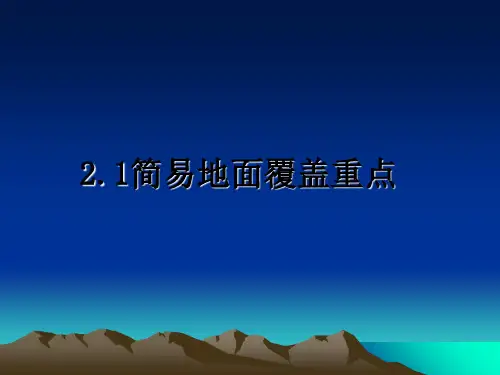
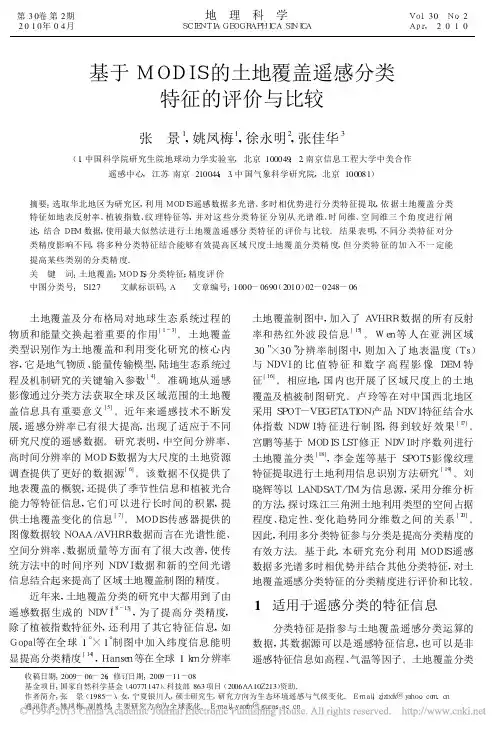
收稿日期:2009-06-26;修订日期:2009-11-08基金项目:国家自然科学基金(40771147)、科技部863项目(2006AA10Z213)资助。
作者简介:张 景(1985-),女,宁夏银川人,硕士研究生,研究方向为生态环境遥感与气候变化。
E-mail:zjztxfx@yahoo.com.cn通讯作者:姚凤梅,副教授,主要研究方向为全球变化。
E-mail:yaofm@gucas.ac.cn基于MODIS的土地覆盖遥感分类特征的评价与比较张 景1,姚凤梅1,徐永明2,张佳华3(1.中国科学院研究生院地球动力学实验室,北京100049;2.南京信息工程大学中美合作遥感中心,江苏南京210044;3.中国气象科学研究院,北京100081)摘要:选取华北地区为研究区,利用MODIS遥感数据多光谱、多时相优势进行分类特征提取,依据土地覆盖分类特征如地表反射率、植被指数、纹理特征等,并对这些分类特征分别从光谱维、时间维、空间维三个角度进行阐述,结合DEM数据,使用最大似然法进行土地覆盖遥感分类特征的评价与比较。
结果表明,不同分类特征对分类精度影响不同,将多种分类特征结合能够有效提高区域尺度土地覆盖分类精度,但分类特征的加入不一定能提高某些类别的分类精度。
关 键 词:土地覆盖;MODIS;分类特征;精度评价中图分类号:S127 文献标识码:A 文章编号:1000-0690(2010)02-0248-06 土地覆盖及分布格局对地球生态系统过程的物质和能量交换起着重要的作用[1~3]。
土地覆盖类型识别作为土地覆盖和利用变化研究的核心内容,它是地气物质、能量传输模型,陆地生态系统过程及机制研究的关键输入参数[4]。
准确地从遥感影像通过分类方法获取全球及区域范围的土地覆盖信息具有重要意义[5]。
近年来遥感技术不断发展,遥感分辨率已有很大提高,出现了适应于不同研究尺度的遥感数据。
研究表明,中空间分辨率、高时间分辨率的MODIS数据为大尺度的土地资源调查提供了更好的数据源[6]。
一、Modis数据资源总体介绍1999年2月18日,美国成功地发射了地球观测系统(EOS)的第一颗先进的极地轨道环境遥感卫星Terra。
它的主要目标是实现从单系列极轨空间平台上对太阳辐射、大气、海洋和陆地进行综合观测,获取有关海洋、陆地、冰雪圈和太阳动力系统等信息,进行土地利用和土地覆盖研究、气候季节和年际变化研究、自然灾害监测和分析研究、长期气候变率的变化以及大气臭氧变化研究等,进而实现对大气和地球环境变化的长期观测和研究的总体(战略)目标。
2002年5月4日成功发射Aqua星后,每天可以接收两颗星的资料。
搭载在Terra和Aqua两颗卫星上的中分辨率成像光谱仪(MODIS)是美国地球观测系统(EOS)计划中用于观测全球生物和物理过程的重要仪器。
它具有36个中等分辨率水平(0.25um~1um)的光谱波段,每1-2天对地球表面观测一次。
获取陆地和海洋温度、初级生产率、陆地表面覆盖、云、汽溶胶、水汽和火情等目标的图像。
本网站提供的MODIS陆地标准产品来自NASA的陆地过程分布式数据档案中心(The Land Processes Distributed Active Archive Center,LP DAAC/NASA)。
包括:基于Terra星和Aqua星数据的地表反射率(250m,daily;500m,daily;250m,8days;500m,8day)、地表温度(1000m,daily;1000m,8days;5600m,daily)、地表覆盖(500m,96days;1000m,yearly)、植被指数NDVI&EVI (250m,16daily;500m,16days;1000m,16days;1000m,monthly;、温度异常/火产品(1000m,daily;1000m,8days)、叶面积指数LAI/光合有效辐射分量FPAR(1000m,8days)、总初级生产力GPP(1000m,8days)。